|
Boletín de la Sociedad Geológica Mexicana Volumen 74, núm. 2, A240322, 2022 http://dx.doi.org/10.18268/BSGM2022v74n2a240322
|
 |
Microbiostratigraphy, microfacies analysis and lateral basin evolution of Lower Cretaceous deposits in the south of Kerman region, SE Iran
Microbioestratigrafía, análisis de microfacies y evolución lateral de la cuenca de los depósitos del Cretácico Inferior en la región sur de Kerman, SE Irán
Mohammad Javad Hassani1,*
1 Department of Ecology, Institute of Science and High Technology and Environmental Sciences, Graduate University of Advanced Technology, End of Haft Bagh Highway, Kerman, Iran.
*Corresponding author: (M.J. Hassani) This email address is being protected from spambots. You need JavaScript enabled to view it. , This email address is being protected from spambots. You need JavaScript enabled to view it.
How to cite this article:
Hassani, M.J., Microbiostratigraphy, microfacies analysis and lateral basin evolution of Lower Cretaceous deposits in the south of Kerman region, SE Iran: Boletín de la Sociedad Geológica Mexicana, 74 (2), A240322. http://dx.doi.org/10.18268/BSGM2022v74n2a240322
Manuscript received: February 7, 2022; Corrected manuscript received: March 10, 2022; Manuscript accepted: March 23, 2022.
ABSTRACT
Detailed microbiostratigraphy and basin evolution of the Lower Cretaceous deposits in the Rayen area, south of Kerman Region, SE Iran are investigated for the first time in two sections. The section no. 1 is 324.6m in thickness and comprises five lithostratigraphic units. The section no. 2 is 218 m in thickness and includes three lithostratigraphic units. The identified fauna and flora include 41 benthic foraminifera and 11 calcareous algae species. The identified assemblage indicates that the marine strata in both sections were deposited during the Barremian to Albian. The microfacies analyses carried out on 22 carbonate and 2 clastic microfacies indicate that the deposits in the section no. 1 were deposited on a homoclinal carbonate ramp, whereas in the section no. 2 they were deposited on a rimmed carbonate shelf. Generally, the Cretaceous deposit in the two studied sections represent different sedimentary models and fossil content indicating different basin evolution histories. The paleogeographic setting of the studied area on the south eastern margin of the Central-East Iranian Microcontinent and the active tectonic history during the Mesozoic suggest that the syndepositional tectonism influenced the basement’s morphology and resulted in changes in the fossil diversity and sedimentary nature of adjacent sedimentary basins.
Keywords: Lower Cretaceous, CEIM, basin evolution, Kerman, Rayen.
RESUMEN
La microbioestratigrafía detallada y la evolución de la cuenca de los depósitos del Cretácico Inferior en el área de Rayen, al sur de la región de Kerman, sureste de Irán, se investigan por primera vez en dos secciones. La sección núm. 1 tiene 324.6 m de espesor y comprende cinco unidades litoestratigráficas. La sección núm. 2 tiene 218 m de espesor e incluye tres unidades litoestratigráficas. La fauna y flora identificada incluye 41 foraminíferos bentónicos y 11 especies de algas calcáreas. El conjunto identificado indica que los estratos marinos en ambas secciones fueron depositados durante el Barremiense al Albiense. Los análisis de microfacies realizados en 22 microfacies carbonatadas y 2 clásticas indican que los depósitos en la sección no. 1 se depositaron en una rampa de carbonato homoclinal, mientras que en la sección no. 2 se depositaron en una plataforma carbonatada con borde. En general, el depósito del Cretácico en las dos secciones estudiadas representan diferentes modelos sedimentarios y contenido fósil que indican diferentes historias de evolución de la cuenca. El marco paleogeográfico del área estudiada en el margen suroriental del microcontinente iraní centro-oriental y la historia tectónica activa durante el Mesozoico sugieren que el tectonismo sindeposicional influyó en la morfología del basamento y resultó en cambios en la diversidad fósil y la naturaleza sedimentaria de sedimentos adyacentes. cuencas.
Palabras clave: Cretácico Inferior, CEIM, evolución de cuencas, Kerman, Rayen.
- Introduction
The Lower Cretaceous beds in the Central-East Iranian Microcontinent (CEIM) comprise mainly of carbonate deposits and subordinately of clastic rocks. The sedimentary nature and fossil content of these beds vary in synchronous deposits in the adjacent areas. These variations in sedimentological and paleontological characteristics, reflect different basin evolution history and morphology of the basement. Due to this variation in the Lower Cretaceous, and also Upper Cretaceous , deposits, it is impossible to classify them as standard formations in the CEIM and the previously modified formations (Dareh Zanjir, Debarsu and Shah Kuh) are locally applicable. In the Kerman region, as a major part of the CEIM, the Lower Cretaceous deposits are cropped out as rough mountains, mainly in the northern half of the region.
Because of their poor and non-familiar fossil content and rough topography, the Lower Cretaceous layers are poorly known in Kerman region.
The biostratigraphy and paleoecology of some localities in CEIM were carried out by some authors ( Bucur et al., 2003; Yazdi-Moghadam and Amiri, 2010; Bucur et al., 2012; Rami et al., 2012; Schlagintweit et al., 2013a, 2013b, 2013c; Wilmsen et al., 2013; Khodashenas et al., 2014; Hanifzadah et al., 2015; Hosseini et al., 2016; Hairapetian et al., 2018).
The main problem is that the correlation between the Cretaceous deposits in the Kerman area is very difficult and many of outcrops have not been divided to standard lithostratigraphic units yet. Dimitrijevic (1973) emphasized that the Jupar Mountain Complex includes the most complete and thickest Cretaceous deposits in the Kerman region. In this study, detailed microbiostratigraphy and sedimentology of the Lower Cretaceous deposits in the south of the Jupar mountain complex near the Rayen city were studied and investigated for the first time as the first step of a continues project.
- Geological settings
The Cretaceous deposits of the Kerman region are classified in six realms by Dimitrijevic (1973), mainly based on the geographic position (Figure 1A). The present study area is located at southern flank of the Jupar mountain complex near the Rayen Town (Figure 1A). In order to trace the lateral facies and sedimentary basin changes in the study area, 2 section were measured. The section no.1 locates 15 km north of the Rayen Town at 57°24’57.82”E - 29°41’54.37”N, and the section no.2 locates at 57°21’01.94”E - 29°41’51.71”N, 13.8 km northeast of the Rayen town (Figure 1B). Both sections were measured in rough Cretaceous outcrops (Figure 1C). Based on Dimitrijevic and Antonivic (1956), the main surrounding lithostratigraphic units consist of older Mesozoic and Neogene clastic deposits (Figure 1D).
 |
| Figure 1. A, the geographic position of the Cretaceous outcrops in the Kerman region and the location of the studied area (modified after Dimitrijevic, 1973), B, the access map of the sections, C, the sathelite image of the studied sections and outcrops (From Googleearth), D, the simplified geological map of the studied area (after Dimitrijevic and Antonovic 1956). |
- Materials and methods
The Cretaceous succession in section 1 is 324.6 m thick and consists of 5 lithostratigraphic units. The basal unit comprises 82.5 m red sandstone and siltstone/shale intercalations. The second unit is 9.5 m thick and comprise brown sandy/dolomitic limestone. The third unit is a 47.3 m succession of purple to red sandstone and shale with siltstone interbeds. The fourth unit (105.2 m) is composed of medium to thick bedded light to dark gray limestone beds. The last unit composed of 80.1m thick bedded gray orbitolina bearing limestone layers (Figure 2A). All the lithified beds in the section no.1 were sampled and the total of 155 samples were collected. To identifying the fossil content and microfacies, 153 thin sections were prepared.
The section no.2 with the total thickness of 218 m comprises 3 lithostratigraphic units. The first unit consists of 74.5m red to purple shale/sandstone layers with some siltstone intercalations.
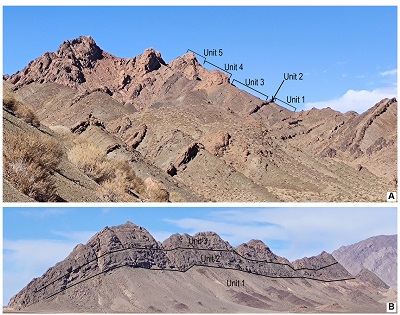 |
| Figure 2. A, the outcrop of the section no 1 with five lithostratigraphic unit, B, the outcrop of the section no 2 with three lithostratigraphic unit. |
The total thickness of the second unit is 110 m and consists of 75 m medium to thick bedded limestone succession at the lower part, 25 m coral reef at the middle and 10m thick foraminifera bearing limestone at the end. The third unit comprises of 33.5m thick bedded limestone with minor fossil bearing layers (Figure 2B). Similar to the section no.1, hard layers of the section no.2 were sampled and 130 samples were collected and 120 thine sections were prepared. The microfacies analyses are based on the Flügel (2010) and the microfacies classification fallows modified method of Dunham (1962) by Embry and Kolvan (1972). The studied thine section hosed in the Graduate University of Advanced Technology paleontology Lab.
- Biostratigraphy
The identified microfossils include 41 species of benthic foraminifera and 11 species of calcareous algae. The microfossil content of the two studied sections includes smaller benthic foraminifera and calcareous algae. The section no.1 represents more diverse and more abundant microfossils than the section no.2.
4.1. BIOSTRATIGRAPHY OF SECTION NO.1
The basal (unit 1) and the upper clastic deposits (unit 3) of the section no.1 are fossil less and in the unit 2 poorly preserved Orbitolina and miliolida have seen. The age of these three units may to Berirasian-Hauterivian based on their stratigraphic setting. In the lower half of the unit 4, a relatively diverse community of Early Cretaceous species is recorded (Figure 3). Based on these species, this part of the unit 4 belongs to the Barremian. The Barremian-Aptian boundary is recorded in unit 4 and is marked by the first occurrence datum (FOD) of the Cuneolina sliteri Arnaud-Vanneau, Premoli Silva, 1995, Charentia cuvillieri Neumann, 1965 and Choffatella cf. decipiens Schlumberger, 1905 ( Seyed-Emami et al., 1971; Husinec and Sokač, 2006; Omaña and Alencáster, 2009; Khodashenas et al., 2014).
 |
| Figure 3. The biotic ranges of recorded benthic foraminifera and calcareous algae in the section no.1. |
The last occurrence datum (LOD) of Acicularia sp., Bakalovella elitzae Bakalova, 1971, Clypeina gigantean Sokač, 1996 and Terquimella sp. have also been recorded in this boundary that confirms the end of the Barremian (Dragastan, 1999; Granier, 2001; Mancinelli and Chiocchini, 2006; Taherpour Khalil Abad, 2017). The Lower/Upper Aptian boundary is marcked by the FOD of Mesorbitolina parva Douglass, 1960 and LOD of Praeorbitolina cormyi Schroeder, 1964 and Palorbitolina lenticularis Blumenbach, 1805 (Schroeder et al., 2010) and recorded in the basal layers of the unit 5. At the nearly final layers of the section no.1, (the upper layers of the unit 5) the FOD of Mesorbitolina aperta Erman, 1854 and Neoiraqia insolita Decrouez, Moullade, 1974 and LOD of Orbitolina subconcava Leymerie, 1878 are recorded and point to the Aptian-Albian boundary (Schroeder et al., 2010).
4.2. BIOSTRATIGRAPHY OF SECTION NO.2
The clastic deposits of unit 1 in the section no.2 are fossil less, but the same as the clastic deposits of the section no.1, the stratigraphic position of them points to the Berriasian-Hauterivian age.
Several species of benthic foraminifera and calcareous algae have recorded in the basal layers of unit 2 (Figure 4). In these layers the FOD of C. cuvillieri, C. sliteri, Dyctyoconus pachy-marginalis (Schroeder,1964), Melathrokerion valserinensis Brönnimann Conrad 1967, Sabaudia minuta Hofker 1965 and Voloshinoides murgensis Luperto Sinni, Masse, 1993, and LOD of Comaliamma charentiiformis Loeblich, Tappan, 1985, Novalesia cornucopia Arnaud-Vanneau, 1980, Rumanoloculina robusta Neagu, 1968 and Valserina bronimanni Schroeder, Conrad 1968, points to the Barremian-Aptian boundary (Arnaud-Vanneau, 1980; Granier, 1988; Arnaud-Vanneau and Sliter, 1995; Arnaud Vanneau and Silva, 1995; Kirmaci et al., 1996; Bucur and Săsăran, 2005a; Husinec and Sokač, 2006; Mancinelli and Chiocchini, 2006; Velic, 2007; Omaña and Alencáster, 2009; Schroeder et al., 2010; Yazdi-Moghadam, Amiri, 2010; Bucur et al., 2012; Di Lucia et al., 2012; Ghanem et al., 2012; Carević et al., 2013; Schlagintweit et al., 2013c; Khodashenas et al., 2014; Yavarmanesh et al., 2017; Yazdi-Moghadam et al., 2017; Neamţu, 2019).
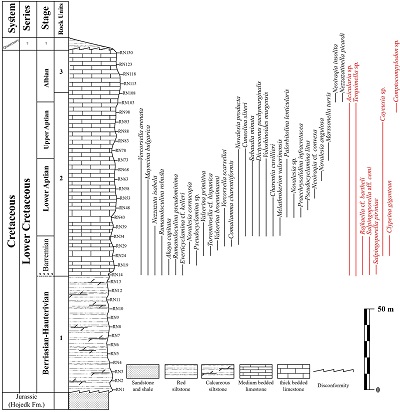 |
| Figure 4. The biotic ranges of recorded benthic foraminifera and calcareous algae in the section no.2. |
This boundary also marked by the LOD of Clypeina gigantean, Rajkaella cf. bartheli Bernier, 1971 and Salpingoporella aff. cemi of calcareous algae (Sokač, 1996; Yilmaz, 2000; Bucur and Săsăran, 2005a, 2005b; Granier, 2001; Schlagintweit, 2011; Abyat et al., 2012; Bucur et al., 2013; Carević et al., 2013; Taherpour Khalil Abad, 2017; Neamţu, 2019).
The Lower/Upper Aptian limit is demonstrated by the FOD of Marssonella turris d’Orbigny, 1839 (Rami et al., 2012) and LOD of Dyctyoconus pachymarginalis, Palorbitolina lenticularis, Sabaudia minuta and Voloshinoides murgensis (Schroeder et al., 2010). The Aptian-Albian limit is marked by the FOD of Neoiraqia insolita and Nezzazatinella picardi Henson, 1948 (Husinec and Sokač, 2006; Velic, 2007; Spalluto and Caffau, 2010) and LOD of Acicularia sp., Comptocompylodon sp. and Terquimella sp.
Despite the similarities in microfossil content of both sections, there are some differences between the fossils and the fossil diversity in them. The most fundamental difference is the dominance of orbitolinidae in the section no.1 while these faunae are poorly recorded in the section no.2.
On the other hand, section no.2 contains more calcareous algae than section no.1. Also, the thickness of the Albian strata in the section no.2 is twice as thick as there in the section no.1.
In general, the identified foraminifera assemblage in the studied area shows higher diversity than other studied areas in CEIM, Alborz, Zagros and kopet Dagh structural zones (Yazdi-Moghadam and Amiri, 2010; Roozbahani, 2011; Rami et al., 2012; Bucur et al., 2013; Schlagintweit et al., 2013a, 2013b; Wilmsen et al., 2013; Khodashenas et al., 2014; Schlagintweit and Wilmsen, 2014; Babazadeh and Dehej, 2015; Hanifzadah et al., 2015; Hosseini et al., 2016; Rahiminejad and Hassani, 2016a, 2016b; Yavarmanesh et al., 2017; Yazdi-Moghadam et al., 2017; Gheiasvand et al., 2020; Moosavizadeh et al., 2020).
The identified calcareous algae assemblage is not as diverse as the foraminifera assemblage, while there are many sections with rich fossil algae have reported from CEIM (Bucur et al., 2003; Bucur and Săsăran, 2005b; Bucur et al., 2012; Bucur et al., 2013; Hanifzadah et al., 2015; Taherpour Khalil Abad, 2017; Bucur et al., 2018).
- Microfacies analyzes and sedimentary model
The microfacies are include 22 calcareous and 2 terrigenous that some of them recorded in both sections. Although the general lithological features of the Cretaceous successions in both sections are the same, but they represent different types of microfacies. Details of the identified microfacies in the studied sections are represented in the table 1.
| Table 1. The identified microfacies in the studied sections, Al= Algae, BFT, benthic foraminifera tests, Br= bryozoan, CAOT= conical and abraded orbitolina, Ct= Cuneolina tests, DOT= Discoidal orbitolina tests, IC= intraclasts, MSF, Mollusca shell fragments, MT= Miliolidea tests, PFT= planktonic foraminifera test, Pl= peloids, Q=Quartz, RF=Rock fragments, SDOT= Semidiscoidal to discoidal orbitolina tests, SF= shell fragments, SOT= Semidiscoidal orbitolina tests, Sp= Sand particles. |
 |
5.1. MICROFACIES ANALYZES AND SEDIMENTARY MODEL OF SECTION NO.1
Based on the microfacies in the section no.1, (table 1), the facies belts in this section are include supratidal, intratidal, shallow restricted lagoon, sand shoals, non-restricted lagoon, patch reef and open marine. These facies belts (figure 5) and the lack of onchoids, continuous reef layers, turbidites and dominance of orbitolinidae suggest an homoclinal carbonate ramp depositional model in the section no.1’s location (Adabi et al., 2010; Flügel, 2010, 2012). The inner ramp facies association includes intratidal, shallow restricted lagoon and sand shoal facies belts. The middle ramp facies association includes non-restricted lagoon and patch reef facies belts and the outer ramp facies association includes open marine facies belt.
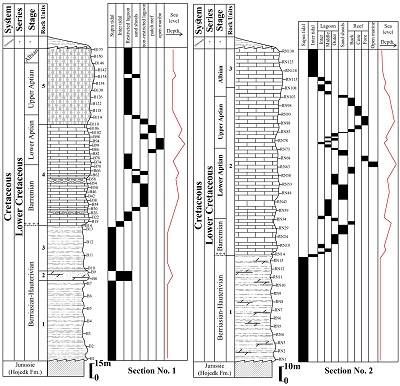 |
| Figure 5. The dominance pattern of the facies belts in the studied sections. |
The most common marine deposits in the section no 1. are deposited in the shallow lagoon facies belts. The deposits of the inner ramp facies association are the thickest one in this section. On the other hand the dominance of orbitolinidae, specially discoidal to mostly discoidal forms (Rahiminejad and Hassani, 2016a, 2016b), and the presence of algae indicates that the main depth of the depositional basin was not as deep as the euphotic zone (~50m).
5.2. MICROFACIES ANALYZES AND SEDIMENTARY MODEL OF SECTION NO.2
The present microfacies in the section no.2 (table 1) represent supratidal, intertidal, lagoon (Inner, Middle, Outer), sand shoal, reef (back reef, reef, fore reef) and open marine facies belts (figure 5). In this case, a rimmed shelf depositional model has suggested base on the presence of the thick and continuous coral reef belt, well developed fore and back reef belts and continuous algae bearing facies. The dominance of lagoon deposits, algae bearing microfacies and porcelaneous and agglutinate taxa in the section no2. and the well-developed coral reef facies points to the shallow marine setting in this section (BouDagher-Fadel, 2008; Flügel, 2010, 2012).
The differences between depositional models in the studied area show that the sedimentary environment has changed from ramp carbonate platform to rimmed shelf northwardly (Figure 6). As outlined above (see introduction) these sedimentology differences is common in the Cretaceous outcrops in the CEIM and could be traced in whole area. The most important question in this case is the reason for these changes. In general, the morphology of the continent margin and global sea level changes are the major controlling factor in the basin evolution during the basin life (Miall, 1984). Although long term rifting, orogeny and epeirogeny movements and global climatic shifts have controlled the changes in sedimentary basins along ocean margins; the local sharp and sudden changes may have resulted by local tectonic activities.
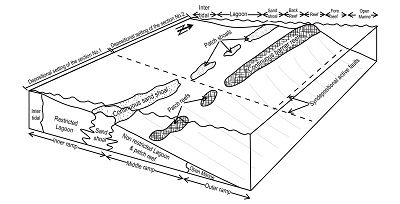 |
| Figure 6. The comprehensive depositional model for the studied outcrops. |
During the lower Cretaceous, the studied area, as a part of CEIM, was located on the northern margin of the Neo- Tethys Ocean (figure 7). During the Lower Cretaceous, the CEIM and the studied area have been affected by compression tectonic tensions of the opening of the Sistan Ocean (at the north of CEIM) and northward movements of the Noe-Tethys crust (at the south of CEIM). This nearly bi- directional stress resulted in to the various sized horst and grabbens in the basement during the deposition of the Lower Cretaceous strata. Therefore, it would be concluded that the clastic deposits and homoclinal ramp system deposits may have deposited on the uplifted areas (horsts) and deep marls, chalks and rimmed shelf system sediments may have deposited on the depressed areas (grabbens). This scenario also explained the lower thickness of the Albian strata in the section no.1; in this case, during the Early Albian the location of the section no. 1 may uplifted to shallower depth and Albian deposits have no enough space to well develop; this uplift shifts the favorable ecological conditions to no favorable that reflects by the sudden decrease in faunal content. The adjacent ruggedness in the basement could be traced in the whole southern realm of the CEIM domain by sudden changes in the biostratigraphic and lithostratigraphic characteristics of the Cretaceous outcrops. The Sistan Ocean completely closed in the early Cenozoic and the whole CEIM uplifted, but there are many steel active faults in this region (Nowroozi , Mohajer-Ashjai, 1985).
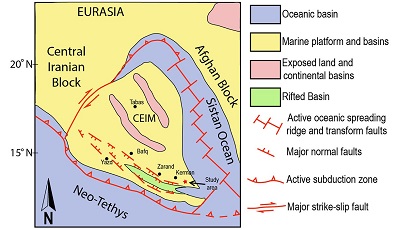 |
| Figure 7. The paleogeographic position of the Kerman Region and the studied area during the Early Cretaceous (modified after Pirnia et al., 2020). |
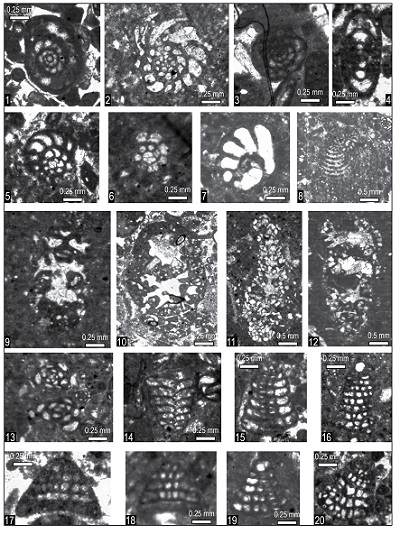 |
| Figure 8. 1, Charentia cuvillieri, 2, Mayncina bulgarica, 3, Melathrokerion valserinensis, 4, Melathrokerion valserinensis, 5, Comaliamma sp., 6, Nezzazata isabela, 7, Nezzazatinella picardi, 8, Choffatella cf. decipiens, 9, Everticyclamina cf. kelleri, 10, Pseudocyclammina lituus, 11, Pseudocyclamina sp., 12, Torremiroella cf. hispanica, 13, Rumanoloculina pseudominima_Rumanoloculina robusta, 14, Akaya sp., 15, Cuneolina sliteri, 16, Cuneolina sliteri, 17-18, kaeveria fluegeli, 19-20, Sabaudia minuta. |
 |
| Figure 9. 1, Novalesia angulosa, 2-3, Novalesia producta, 4-5, Praechrysalidina infracretacea, 6-7, Vercorsella scarsellai, 8-9, Vercorsella arenata, 10-11, Voloshinoides murgensis, 12, Acicularia sp., 13-14, Terquimella sp., 15, Salpingoporella piriniae, 16, Bakalovella elitzae, 17, Clypeina gigantean, 18, Dissocladella cf. intercedens, 19, Rajkaella sp., 20-21, Comptocompylodon sp., 22, Cayeuxia sp., 23, Salpingoporella cf. granieri. |
- Conclusion
The biostratigraphy studies on Lower Cretaceous outcrops in the CEIM, near the Rayen town, SE Iran, resulted in identification of 42 species of benthic foraminifera and 11 species of algae. The identified fauna and flora show that the marine beds in the two studied sections were deposited during the Barremian to Albian. the total of 22 carbonate and 2 clastic microfacies were recognized in the studied sections. The sedimentary model for studied sections have been simulated based on the present microfacies and facies belts in each section. These studies indicate that the Lower Cretaceous beds in the section no. 1 were deposited on a homoclinal carbonate ramp. This carbonate ramp included inner ramp (with supra tidal, inter tidal, restricted lagoon and sand shoal facies belts), middle ramp (with non-restricted lagoon and patch reef facies belts) and outer ramp (with open marine) facies associations. The section no2. has been deposited on a rimmed carbonate shelf with supra tidal, inter tidal, lagoon (inner, middle, outer), sand shoals, reef (back reef, reef, fore reef) and open marine facies belts. These studies show that, despite of same age, there are some fundamental differences between these two adjacent sections. The main differences are including the dominance of orbitoninidea in the section no.1, the higher abondance of algae in the section no2, the lower thickness of the Albian deposits in the section no. 1, as the most thick and complete on, than the section no.2 and the different sedimentary model. These differences in fossil content and sedimentary models are common in the Cretaceous outcrops in the studied area and also across the CEIM. The paleogeographic setting of the studied outcrops on southeastern margin of the CEIM and syndepositional tectonic activities resulted to the vertical movements of neighbored blocks. These movements have resulted to the heterogenous morphology of the basements and affected the sedimentary nature and faunal content of whole Cretaceous deposits.
 |
| Figure 10. 1-2, Dictyoconus pachymarginalis, 3, Neoiraqia insolita, 4, Neoiraqia cf. convexa, 5, Valserina bronimanni, 6, Valserina primitiva, 7, Paleorbitolina lenticularis, 8-9, Mesorbitolina parva, 10, Mesorbitolina texana, 11, Mesorbitolina aperta, 12, Mesorbitolina cormyi. |
Contributions of authors
The author of this article declares that he participated in all its elaboration: conceptualization, data analysis, methodological-technical development, writing of the original manuscript, drafting of the corrected and edited manuscript, graphic design, fieldwork, and interpretation.
Financing
This research has been financially supported by the Institute of Science and High Technology and Environmental Sciences, Graduate University of Advanced Technology, Kerman, Iran, under grant number of 97/2749.
Acknowledgements
This research has been supported by Institute of Science and High Technology and Environmental Sciences, Graduate University of Advanced Technology (Kerman, Iran) under grant number of 97/2749.
Conflicts of interest
The author has no conflicts of interest to declare.
References
Abyat, A., Baghbani, D., Afghah, M.K. Kohansal Ghadimvand, N., Feghi, A., 2012, Microbiostratigraphy and Lithostratigraphy of Fahliyan and Gadvan Formations in Kuh-e-Surmeh (Zagros Basin, Southwest Iran): Advances in Environmental Biology, 6(12), 3078-3086. https://doi.org/10.18488/journal.10/2015.4.4/10.4.68.77
Adabi.M.H., Salehi, M.A., Ghabeishavi, A., 2010, Depositional environment, sequence stratigraphy and geochemistry of Lower Cretaceous carbonates (Fahliyan Formation), south-west Iran: Journal of Asian Earth Sciences, 39, 148-160. https://doi.org/10.1016/j.jseaes.2010.03.011
Arnaud-Vanneau, A., 1980, Micropaléontologie, paléoécologie, et sédimentologie d’une plate-forme carbonatée de la marge passive de la Téthys: l’Urgonien du Vercors septentrional et de la Chartreuse (Alpes occidentales): Français, Universite Scientifique et Medicale de Grenoble, Doctoral dissertation, 876p.
Arnaud-Vanneau, A., Sliter, W.V., 1995, Early Cretaceous shallow-water benthic foraminifers and fecal pellets from Leg 143 compared with coeval faunas from the Pacific Basin, Central America, and the Tethys Northwest Pacific atolls and guyots: Proceedings of the Ocean Drilling Program Scientific Results, 142, 537-564.
Arnaud-Vanneau, A., Silva, I.P., 1995, Biostratigraphy and systematic description of benthic foraminifers from Mid-Cretaceous shallow-water carbonate platform sediments at sites 878 and 879 (Mit and Takuyo-Daisan Guyots): Proceedings of the Ocean Drilling Program Scientific Results, 144, 199-219.
Babazadeh, S.A., Dehej, T.E., 2015, Stratigraphical Study of the Taft Formation in the Bohruk Area from Yazd Block, Central Iran: Journal of Earth Science, 26, 729-739. https://doi.org/10.1007/s12583-015-0580-5
BouDagher-Fadel, M.K., 2008, Evolution and geological significance of larger benthic foraminifera: Amsterdam, Elsevier, 544p.
Bucur, I., Majidifard, M.R., Senowbari-Daryan, B., 2013, Early Cretaceous calcareous benthic microfossils from the Eastern Alborz and Western Kopet Dagh (northern Iran) and their stratigraphic significance: Acta Palaeontologica Romaniae, 9, 23-37.
Bucur, I.I., Rashidi, K., Senowbari-Daryan, B., 2012, Early Cretaceous calcareous algae from central Iran (Taft Formation, south of Aliabad, near Yazd): Facies, 58, 605-636. https://doi.org/10.1007/s10347-012-0303-7
Bucur, I.I., Săsăran, E., 2005a, Micropaleontological assemblages from the Upper Jurassic-Lower Cretaceous deposits of Trascău Mountains and their biostratigraphic significance: Acta Paleontologica Romaniae, 5, 27-38.
Bucur, I.I., Săsăran, E., 2005b, Relationship between algae and environment: an Early Cretaceous case study, Trascău Mountains, Romania: Facies, 51, 275-287. https://doi.org/10.1007/s10347-005-0001-9
Bucur, I.I., Senowbari-Daryan, B., Majidifard, M.R., 2003, Neocomian microfossil association from the Taft area near Yazd (Central Iran): Facies, 48, 217-222. https://doi.org/10.1007/bf02667540
Bucur, I.I., Yarahmadzahi, H., Mircescu, C.V., 2018, The lower Cretaceous Tirgan Formation in the Gelian Section (Kopet Dagh, north Iran): microfacies, microfossils, and their biostratigraphic significance: Acta Palaeontologica Romaniae, 15, 13-33.
Carević, I., Taherpour Khalil Abad, M., Ljubović-Obradović, D., Vaziri, S.H., Mirković, M., Aryaei, A.A., Stejić, P., Ashouri, A.R., 2013, Comparisons between the Urgonian platform carbonates from eastern Serbia (Carpatho-Balkanides) and northeast Iran (Kopet-Dagh Basin): Depositional facies, microfacies, biostratigraphy, palaeoenvironments and palaeoecology: Cretaceous Research, 40, 110-130. https://doi.org/10.1016/j.cretres.2012.06.003
Di Lucia, M., Trecalli, A., Mutti, M., Parente, M., 2012, Bio-chemostratigraphy of the Barremian-Aptian shallow-water carbonates of the southern Apennines (Italy): pinpointing the OAE1a in a Tethyan carbonate platform: Solid Earth, 3,1-28. https://doi.org/10.5194/se-3-1-2012
Dimitrijevic, M.D., 1973, Geology of Kerman Region: Tehran, Geological Survey of Iran, 334p.
Dimitrijevic, M.D., Antonivic, A., 1956, Rayen, scale 1:100,000, Geological map of Iran series, Geological Survey of Iran.
Dragastan, O., 1999, Early Cretaceous algae of Aliman (South Dobrogea): a revision and description of two new species from East Carpathians: Acta Palaeontologica Romaniae, 2, 125-137.
Flügel, E., 2010, Microfacies of Carbonate Rocks (Analysis, Interpretation and Application), 2b ed: New York, Springer. https://doi.org/10.1007/978-3-642-03796-2
Flügel, E., 2012, Microfacies analysis of limestones: New York, Springer. https://doi.org/10.1007/978-3-642-68423-4
Ghanem, H., Mouty, M., Kuss, J., 2012, Biostratigraphy and carbon-isotope stratigraphy of the uppermost Aptian to Upper Cenomanian strata of the South Palmyrides, Syria: Geo Arabia, 17, 155-184. https://doi.org/10.2113/geoarabia1702155
Gheiasvand, M., Ahouri, A.R., Aghanabati, S.A., Taherpour-Khalil-Abad, M. Ghaderi, A., 2020, Stratigraphic distribution of shallow-water benthic foraminifera from the Lower Cretaceous Taft formation, Central Iran (Yazd Block), with evidence for the importance of hiatuses: Annales de Paléontologie, 106, 1-13. https://doi.org/10.1016/j.annpal.2020.102399
Granier, B., 1988, Algues Chlorophyceae du Jurassique terminal et du Crétacé inférieur en Alicante: Mediterranea, 5, 5-84.
Granier, B., 2001, Stratigraphic distribution of the Mesozoic Dasycladalean algae: Available in: http://deptsec. ku. edu/~ ifaaku/pdf/Mesozoic-Dasyclads-1-01. pdf
Hairapetian, V., Wilmsen, M., Ahmadi, A., Shojaei, Z., Berensmeier, M., Majidifard, M.R., 2018, Integrated stratigraphy, facies analysis and correlation of the upper Albian–lower Turonian of the Esfahan area (Iran): Unravelling the conundrum of the so-called “Glauconitic Limestone”: Cretaceous Research, 90, 391-411. https://doi.org/10.1016/j.cretres.2018.06.014
Hanifzadah, R., Rashidi, K., Shahkarami, M.A., 2015, Barremian-Aptian Biostratigraphy in Yazd Block, Central Iran: Open Journal of Geology, 5405-421. https://doi.org/10.4236/ojg.2015.56039
Hosseini, S., Vahidinia, M., Najafi, M., Musaviharami, R., 2016, Biostratigraphy, Sedimentary environment and Sequential stratigraphy of Lower Cretaceous clastic-carbonate deposits, East Central Iran, Dehuk: Kharazmi Geoscience, 2, 157-180. https://doi.org/10.29252/gnf.2.2.157
Husinec, A. Sokač, B., 2006, Early Cretaceous benthic associations (foraminifera and calcareous algae) of a shallow tropical-water platform environment (Mljet Island, southern Croatia): Cretaceous Research, 27, 418-441. https://doi.org/10.1016/j.cretres.2005.07.008
Khodashenas, N., Aryaei, A.A., Ashouri, A., 2014, Early Cretaceous Index Benthic Foraminifera from Northeast of Torbat-e-Heydarieh Area (Esfiyukh Section): Open Journal of Geology, 4, 206-209. https://doi.org/10.4236/ojg.2014.45016
Kirmaci, M.Z., Koch, R., Bucur, J.I., 1996, An Early Cretaceous section in the Kircaova Area (Berdiga Limestone, NE-Turkey) and its correlation with platform carbonates in W-Slovenia: Facies, 34, 1-21. https://doi.org/10.1007/bf02546154
Mancinelli, A., Chiocchini, M., 2006a, Cretaceous benthic foraminifers and calcareous algae from Monte Cairo (southern Latium, Italy): Bollettino Societa Paleontologica Italiana, 45, 91-113.
Miall, A., 1984, Principles of sedimentary Basin analysis: New York,Springer, 616p. https://doi.org/10.1007/978-3-662-03999-1
Moosavizadeh, S., Zand-Moghadam, H., Rahiminejad, A.H., 2020, Palaeoenvironmental reconstruction and sequence stratigraphy of the Lower Cretaceous deposits in the Zagros belt, SW Iran: Boletín de la Sociedad Geológica Mexicana, 72(2), A060919. https://doi.org/10.18268/bsgm2020v72n2a060919
Neamţu, O., 2019, Upper Jurassic-Lower Cretaceous limestones from the Hăghimaș Massif (Eastern Carpathians, Romania): Microfacies, microfossils and depositional environments: Carnets de géologie (Notebooks on geology), 9(16), 345-368. https://doi.org/10.4267/2042/70499
Nowroozi, A.A., Mohajer-Ashjai, A., 1985, Fault movements and tectonics of eastern Iran: boundaries of the Lut plate: Geophysical Journal International, 83, 512-237. https://doi.org/10.1111/j.1365-246x.1985.tb05164.x
Omaña, L., Alencáster, G., 2009, Lower Aptian shallow-water benthic foraminiferal assemblage from the Chilacachapa range in the Guerrero-Morelos Platform, south Mexico: Revista Mexicana de Ciencias Geológicas, 26, 575-586.
Pirnia, T., Saccani, E., Torabi, G., Chiari, M., Goričan, Š., Barbero, E., 2020, Cretaceous tectonic evolution of the Neo-Tethys in Central Iran: Evidence from petrology and age of the Nain-Ashin ophiolitic basalts: Geoscience Frontiers, 11(1), 57-81. https://doi.org/10.1016/j.gsf.2019.02.008
Rahiminejad, A.H., Hassani, M. 2016a, Depositional environment of the Upper Cretaceous orbitolinid-rich microfacies in the Kuh-e Mazar anticline (Kerman Province, Central Iran): Historical Biology, 28, 597-612. https://doi.org/10.1080/08912963.2014.998667
Rahiminejad, A.H., Hassani, M., 2016b, Paleoenvironmental distribution patterns of orbitolinids in the Lower Cretaceous deposits of eastern Rafsanjan, Central Iran: Marine Micropaleontology, 122, 53-66. https://doi.org/10.1016/j.marmicro.2015.11.006
Rami, M., Vaziri, M.R., Abad, M.T.K., Hosseini, S.A., Carevic, I., Allameh, M., 2012, Microbiostratigraphy of the Lower Cretaceous strata from the Bararig Mountain, SE Iran: Revista Mexicana de Ciencias Geológicas, 29, 63-75.
Roozbahani, P.R., 2011, Lithostratigraphy and biostratigraphy of the Lower Cretaceous of the Jalmajird area (northeast of Khomeyn, Central Iran Basin), Iran: Geo Alp, 9, 48-58.
Schlagintweit, F., 2011, The dasycladalean algae of the Plassen Carbonate Platform (Kimmeridgian-Early Berriasian): taxonomic inventory and palaeogeographical implications within the platform-basin-system of the Northern Calcareous Alps (Austria, pp Germany): Geologia Croatica, 64, 185-206. https://doi.org/10.4154/gc.2011.16
Schlagintweit, F., Bucur, I., Rashidi, K., Saberzadeh, B., 2013a, Bioerosive structures in orbitolinid foraminifera: examples from the Lower Cretaceous of Central Iran: Studia Universitatis Babes-Bolyai, Geologia, 58, 5-12. https://doi.org/10.5038/1937-8602.58.2.1
Schlagintweit, F., Bucur, I.I., Rashidi, K., Hanifzadeh, R., Wilmsen, M., 2013b, Torremiroella hispanica Brun and Canérot, 1979 (benthic foraminifera) from the Lower Cretaceous of Central Iran and its palaeo-biogeographic significance: Cretaceous Research, 46, 272-279. https://doi.org/10.1016/j.cretres.2013.09.008
Schlagintweit, F., Bucur, I.I., Rashidi, K., Saberzadeh, B., 2013c, Praeorbitolina claveli n.sp. (benthic Foraminifera) from the Lower Aptian sensu lato (Bedoulian) of Central Iran: Carnets de Géologie, 4, 255-272. https://doi.org/10.4267/2042/51217
Schlagintweit, F., Wilmsen, M., 2014, Orbitolinid biostratigraphy of the top Taft Formation (Lower Cretaceous of the Yazd Block, Central Iran): Cretaceous Research, 49, 125-133. https://doi.org/10.1016/j.cretres.2014.02.016
Schroeder, R., van Buchem, F.S., Cherchi, A., Baghbani, D., Vincent, B., Immenhauser, A., Granier, B., 2010, Revised orbitolinid biostratigraphic zonation for the Barremian–Aptian of the eastern Arabian Plate and implications for regional stratigraphic correlations: GeoArabia Special Publication, 4, 49-96.
Seyed-Emami, A., Brants, A., Bozorgnia, F., 1971, Stratigraphy of the Cretaceous rocks southeast of Esfahan: Geological Survey of Iran, Tehran, Report no. 20, 5-27.
Sokač, B., 1996, Taxonomic review of some Barremian and Aptian calcareous algae (Dasycladales) from the Dinaric and Adriatic karst regions of Croatia: Geologia Croatica, 49, 1-79. https://doi.org/10.4154/GC.1994.44
Spalluto, L., Caffau, M., 2010, Stratigraphy of the mid-Cretaceous shallow-water limestones of the Apulia Carbonate Platform (Murge, Apulia, southern Italy): Italian Journal of Geosciences, 3, 335-352. https://doi.org/10.3301/ijg.2010.18
Taherpour Khalil Abad, M., 2017, Salpingoporella (dasycladalean algae) species from the Lower Cretaceous carbonate facies of Kopet Dagh basin (NE Iran): Arabian Journal of Geosciences, 10(2), 31-52. https://doi.org/10.1007/s12517-016-2787-x
Velic, I., 2007, Stratigraphy and Palaeobiogeography of Mesozoic Benthic Foraminifera of the Karst Dinarides (SE Europe): Geologia Croatica, 60, 1-113. https://doi.org/10.4154/gc.2007.01c
Wilmsen, M., Fürsich, F.T., Majidifard, M.R., 2013, The Shah Kuh Formation, a latest Barremian – Early Aptian carbonate platform of Central Iran (Khur area, Yazd Block): Cretaceous Research, 39, 183-194. https://doi.org/10.1016/j.cretres.2012.02.013
Yavarmanesh, H., Vaziri, S.H., Aryaei, A.A., Jahani, D., Pourkermani, M., Bouriabadi, E.K., 2017, Benthic Foraminiferal and Calcareous Algae Assemblages in the Tirgan Formation (Urgonien Facies Type) in South Flank of Ghorogh Syncline (North of Chenaran), NE Iran: Open Journal of Geology, 7(6), 796-805. https://doi.org/10.4236/ojg.2017.76054
Yazdi-Moghadam, M., Amiri, F., 2010, Lower Cretaceous Agglutinating Larger Benthic Foraminifera from the Sarvestan Section, south of Esfahan, Iran, in The 1st International Applied Geological Congress: Mashhad, Iran, Department of Geology, Islamic Azad University-Mashad Branch, 976-980.
Yazdi-Moghadam, M., Sarfi, M., Sharifi, M., Ariafar, B., Sajjadi, F., Abbasi, P., 2017, Early Barremian orbitolinid record from the Moghan area, NW Iran: Northern margin of the Neotethys: Cretaceous Research, 77, 133-142. https://doi.org/10.1016/j.cretres.2017.05.014
Yilmaz, İ.Ö., 2000, Taxonomic and Paelogeographic Approaches to the Dasyclad Algae in the Upper Jurassic (Kimmeridgian)-Upper Cretaceous (Cenomanian) Peritidal Carbonates of the Fele (Yassıbel) Area (Western Taurides, Turkey): Turkish Journal of Earth Sciences, 8, 81-102.

